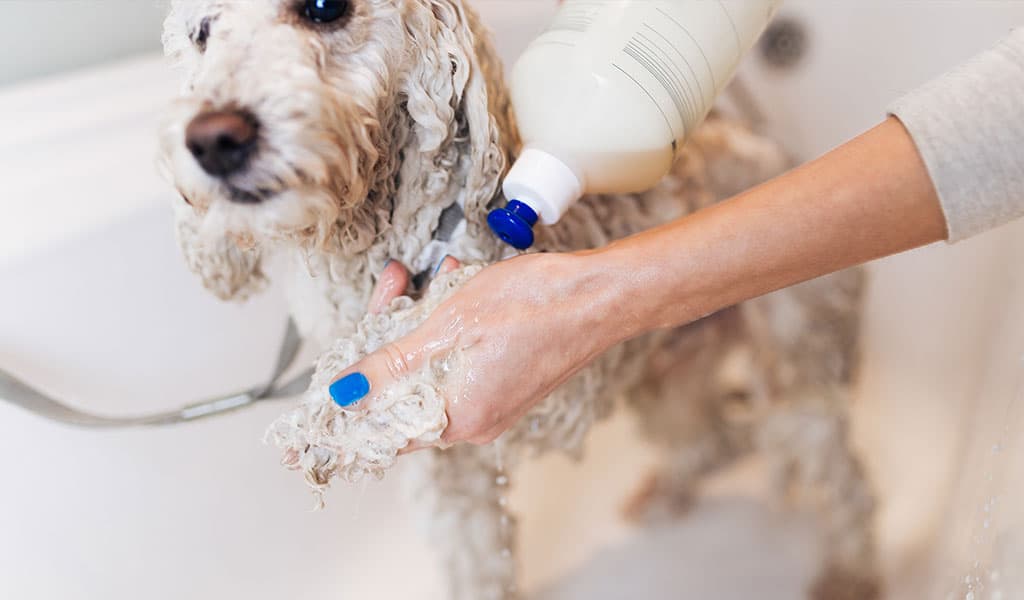Bathing is very important to Poodles in show coat. It is part of the weekly regimen of dogs that are being campaigned as well as for dogs that are growing coat before the start of their show careers. A shampoo maintenance routine is as important as regular brushing because clean hair is healthier and grows faster than dirty hair.
Preparing the dog for a shampoo is as important as the actual shampoo. Trim the Poodle’s toenails before the bath, and clean any debris out of the ears. Brush the hair thoroughly. Remove all topknot and ear wrappers and bands. Plug the ears with cotton to prevent water from reaching the ear canals.
Put a little Vaseline on the end of the cotton if your dog has chronic ear trouble to assure that no water gets inside to further irritate them. Use a tearless shampoo to wash the head area. If you don’t use a tearless shampoo, place a drop or two of mineral oil into each eye to protect them from stinging.
Before putting the dog in the tub, some exhibitors like to part the long mane down the center of the back with a pin brush, letting the long hair fall to either side of the body. It is not mandatory to do this; just keep in mind that your goal is to wash the long hair carefully to keep it from tangling.
When bathing a Poodle in show coat, you don’t want to rub the long hair with your fingers or a sponge, but rather gently squeeze the suds through the coat, as if you were washing a delicate sweater (you can, however, scrub the shorter hair on bracelets, rosettes or pack).
There are two ways to shampoo a Poodle in show coat. The first method is to fill the tub with 3 or 4 inches of warm water, add shampoo, then swirl it around to create suds. Stand the dog in the tub (a rubber mat in the bottom will prevent his from slipping). Use a plastic bowl to scoop up the sudsy water and pour it all over the dog.
The second method, and the one preferred by most professionals, is to stand the dog in the tub, wet him thoroughly with a powerful spray hose, and let the water run free during the shampoo. Before you do this, fill a large container (a plastic bucket, for instance) with water, add shampoo (swirling it around to make suds), and keep it nearby to pour over the dog.
Whichever method you choose is a matter of personal preference, either will get the dog clean.
Wetting a Poodle in show coat, especially hair that is very dense in texture, can take quite a long time. If you are using a spray hose, hold the nozzle close to the body; this will force the water to the skin and flush out any dirt and debris more efficiently.
Before yo u apply shampoo, be sure that all the hair is thoroughly wet down to the skin. Once the dog is wet to the skin, scoop up the sudsy water in a plastic bowl and pour it over and over the dog. Start cleaning the puffs and bracelets on the legs first, then wash the stomach, tail, hindquarters, back and neck, leaving the head and ears until last. Use your fingers to gently work the lather down to the skin.
u apply shampoo, be sure that all the hair is thoroughly wet down to the skin. Once the dog is wet to the skin, scoop up the sudsy water in a plastic bowl and pour it over and over the dog. Start cleaning the puffs and bracelets on the legs first, then wash the stomach, tail, hindquarters, back and neck, leaving the head and ears until last. Use your fingers to gently work the lather down to the skin.
When the Poodle is thoroughly shampooed all over, rinse carefully and shampoo a second time. If you dilute the shampoo even more for the second wash, it will be easier to rinse out. If you are keeping your Poodle in oil, three shampoos may be necessary to remove all oil traces from the coat. (If your shampoo is not strong enough to remove all the oil from the coat, try using the Lux glycerine and vinegar mixture.)
After the second sudsing, you must rinse every trace of shampoo out of the coat. Begin the final rinse at the head. Cover the Poodle’s eyes with your hand. Use warm water. Work methodically with the spray nozzle: down the head and the ears, down the neck and the back toward the tail, over the sides of the body, under the stomach, and down and under the legs to the feet.
Rinse and rinse until clear water comes off the dog. Hold the spray nozzle close to the skin, to flush out all the scurf and dandruff. If the Poodle is standing in water, be sure to pull the plug and let all the suds drain out before beginning the final rinse.
Hair that is not thoroughly rinsed will feel gritty and look dull. It also will be difficult to scissor into a plush-looking finish. It’s much wiser, therefore, to be on the safe side and make sure that all excess shampoo is completely rinsed from the hair.
After the final rinse, your next step depends on your own schedule:
- If you intend to show the dog within a day or so, you will probably want to use a creme rinse or conditioner (such as Hair Care or Bio Groom Super Creme Conditioner) to add moisture to the coat. However, do not use a product so heavy that it causes oil to accumulate on the coat. Mix the conditioner in a plastic bowl, pour it over the long hair and massage it in with your fingers. Leave the conditioner on for the required length of time, then rinse thoroughly once again, carefully squeeze the excess moisture from the coat, blot it with a towel, and dry. This step is also important because it will help to eliminate static electricity.
- If the bath was part of a maintenance or growth/maintenance program and the dog is not going to be shown within a day or so, you must protect the hair from tangling and matting. In this case, you would want to apply a heavier creme rinse or moisturizing conditioner, or to oil the dog after he is shampooed and rinsed.

